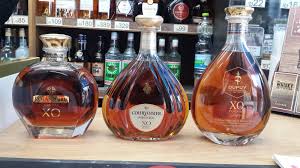
The French cognac industry has reported a sharp 13% decline in revenues over the past year, driven largely by weakening global demand for high-end bottles and significant export disruptions in China. The downturn marks the second consecutive year of contraction for the €3 billion sector, which had previously experienced a boom during the pandemic years. Producers are now grappling with shifting consumer preferences, trade barriers, and geopolitical uncertainties that threaten to reshape the future of the business.
Premium Ranges Under Pressure
For decades, the most profitable part of the cognac business has been the premium ranges—particularly VSOP (Very Superior Old Pale) and XO (Extra Old) expressions—that have commanded high margins and symbolized French luxury abroad. However, sales in these categories have tumbled in the latest reporting period, falling more than 11% for VSOP and nearly 13% for XO. By contrast, entry-level cognacs, especially VS labels, posted modest growth, underscoring a consumer shift toward more affordable options.
The reversal comes after years of price hikes. Producers, led by houses such as Hennessy, Rémy Martin, and Martell, raised prices substantially between 2020 and 2023 to offset inflation in raw materials, energy, and transport. While this strategy initially preserved margins, it also risked pricing out middle-class consumers in Europe and North America. Rising global inflation further dampened appetite for expensive spirits, especially among younger consumers who have shown greater willingness to experiment with alternative beverages such as craft whiskey, Japanese sake, or even premium non-alcoholic drinks.
Another factor undermining demand is the changing cultural dynamic in Asian markets. In China, once the crown jewel of cognac exports, the government has promoted moderation in luxury consumption, encouraging younger generations to adopt more affordable drinking habits. Industry experts note that shifting lifestyles, coupled with economic uncertainty in the region, are reducing demand for status-driven purchases like XO bottles often used as corporate gifts.
Trade Disputes and Export Declines
The most dramatic blow to the industry has come from international trade disputes, particularly with China. Cognac shipments to the country dropped more than 24% over the past year, after Beijing launched an anti-dumping investigation targeting French brandy producers. Provisional duties imposed in late 2024 significantly disrupted imports, making cognac less competitive against domestic and other international spirits. Although a temporary suspension of duties was negotiated in mid-2025, producers remain cautious, uncertain whether Chinese regulators will maintain a more favorable stance in the long run.
The U.S., the other major market for cognac, has also presented challenges. Revenues in North America slid nearly 5%, even though shipment volumes rose slightly. This reflects a pivot toward lower-priced bottles as consumers curbed discretionary spending under pressure from higher living costs and rising credit card debt. The persistence of a general 15% U.S. import levy, despite lobbying efforts by French authorities and industry representatives, continues to erode profitability for exporters.
European markets provided little relief. Revenues fell around 11% as inflation and slowing economic growth weighed on consumer spending. In southern European countries in particular, the hospitality industry has struggled to sustain high sales of luxury cognacs, while northern European markets have seen competition from emerging craft spirits.
The only bright spot has been growth in secondary markets across Africa, Latin America, and Southeast Asia, where exports rose nearly 20% by volume. However, these regions collectively account for less than 15% of total sales, limiting their ability to offset declines in the core U.S. and Chinese markets.
Industry Outlook and Short-Term Strategies
Faced with falling revenues, cognac producers are rethinking their strategies for the near term. The shift in consumer preference toward younger blends and more affordable categories suggests that the industry must adapt by diversifying product lines and broadening appeal beyond luxury branding. Producers are already ramping up marketing for VS ranges, positioning them as versatile spirits suitable for cocktails and casual consumption rather than only for celebratory occasions.
At the same time, companies are redoubling efforts to build resilience in international markets. Many cognac houses are exploring partnerships in India, Vietnam, and African nations to reduce reliance on China and the U.S., although logistics, regulatory frameworks, and consumer education pose challenges. Efforts are also underway to emphasize sustainable production practices, such as reducing carbon emissions in distilleries and promoting environmentally responsible vineyards, in order to appeal to younger consumers who increasingly prioritize sustainability in their purchasing choices.
Industry leaders remain divided on how quickly demand will rebound. Some believe that once inflationary pressures ease in Europe and North America, premium consumption will recover, particularly as luxury remains deeply entrenched in gifting and celebratory traditions. Others caution that the market may have entered a structural shift, with consumer interest spreading toward diverse spirits categories such as tequila, mezcal, or premium rum, leaving cognac with a smaller share of the global luxury beverage segment.
For the near term, cognac producers expect continued pressure on revenues. Growth in entry-level categories may soften the decline but will not fully compensate for the drop in high-margin premium ranges. The industry’s reliance on external markets—particularly in Asia—means that geopolitical shifts, trade negotiations, and regulatory changes will play a defining role in shaping the outlook for the remainder of 2025 and beyond.
What is clear, however, is that the once unstoppable momentum of cognac as a global luxury icon has been checked by a combination of consumer belt-tightening, changing tastes, and fragile trade relations. Whether the industry can regain its footing will depend on its ability to balance tradition with innovation, stabilize relations with key markets, and recapture the aspirational appeal that made cognac one of France’s most successful exports in the first place.
(Source:www.reuters.com)
Premium Ranges Under Pressure
For decades, the most profitable part of the cognac business has been the premium ranges—particularly VSOP (Very Superior Old Pale) and XO (Extra Old) expressions—that have commanded high margins and symbolized French luxury abroad. However, sales in these categories have tumbled in the latest reporting period, falling more than 11% for VSOP and nearly 13% for XO. By contrast, entry-level cognacs, especially VS labels, posted modest growth, underscoring a consumer shift toward more affordable options.
The reversal comes after years of price hikes. Producers, led by houses such as Hennessy, Rémy Martin, and Martell, raised prices substantially between 2020 and 2023 to offset inflation in raw materials, energy, and transport. While this strategy initially preserved margins, it also risked pricing out middle-class consumers in Europe and North America. Rising global inflation further dampened appetite for expensive spirits, especially among younger consumers who have shown greater willingness to experiment with alternative beverages such as craft whiskey, Japanese sake, or even premium non-alcoholic drinks.
Another factor undermining demand is the changing cultural dynamic in Asian markets. In China, once the crown jewel of cognac exports, the government has promoted moderation in luxury consumption, encouraging younger generations to adopt more affordable drinking habits. Industry experts note that shifting lifestyles, coupled with economic uncertainty in the region, are reducing demand for status-driven purchases like XO bottles often used as corporate gifts.
Trade Disputes and Export Declines
The most dramatic blow to the industry has come from international trade disputes, particularly with China. Cognac shipments to the country dropped more than 24% over the past year, after Beijing launched an anti-dumping investigation targeting French brandy producers. Provisional duties imposed in late 2024 significantly disrupted imports, making cognac less competitive against domestic and other international spirits. Although a temporary suspension of duties was negotiated in mid-2025, producers remain cautious, uncertain whether Chinese regulators will maintain a more favorable stance in the long run.
The U.S., the other major market for cognac, has also presented challenges. Revenues in North America slid nearly 5%, even though shipment volumes rose slightly. This reflects a pivot toward lower-priced bottles as consumers curbed discretionary spending under pressure from higher living costs and rising credit card debt. The persistence of a general 15% U.S. import levy, despite lobbying efforts by French authorities and industry representatives, continues to erode profitability for exporters.
European markets provided little relief. Revenues fell around 11% as inflation and slowing economic growth weighed on consumer spending. In southern European countries in particular, the hospitality industry has struggled to sustain high sales of luxury cognacs, while northern European markets have seen competition from emerging craft spirits.
The only bright spot has been growth in secondary markets across Africa, Latin America, and Southeast Asia, where exports rose nearly 20% by volume. However, these regions collectively account for less than 15% of total sales, limiting their ability to offset declines in the core U.S. and Chinese markets.
Industry Outlook and Short-Term Strategies
Faced with falling revenues, cognac producers are rethinking their strategies for the near term. The shift in consumer preference toward younger blends and more affordable categories suggests that the industry must adapt by diversifying product lines and broadening appeal beyond luxury branding. Producers are already ramping up marketing for VS ranges, positioning them as versatile spirits suitable for cocktails and casual consumption rather than only for celebratory occasions.
At the same time, companies are redoubling efforts to build resilience in international markets. Many cognac houses are exploring partnerships in India, Vietnam, and African nations to reduce reliance on China and the U.S., although logistics, regulatory frameworks, and consumer education pose challenges. Efforts are also underway to emphasize sustainable production practices, such as reducing carbon emissions in distilleries and promoting environmentally responsible vineyards, in order to appeal to younger consumers who increasingly prioritize sustainability in their purchasing choices.
Industry leaders remain divided on how quickly demand will rebound. Some believe that once inflationary pressures ease in Europe and North America, premium consumption will recover, particularly as luxury remains deeply entrenched in gifting and celebratory traditions. Others caution that the market may have entered a structural shift, with consumer interest spreading toward diverse spirits categories such as tequila, mezcal, or premium rum, leaving cognac with a smaller share of the global luxury beverage segment.
For the near term, cognac producers expect continued pressure on revenues. Growth in entry-level categories may soften the decline but will not fully compensate for the drop in high-margin premium ranges. The industry’s reliance on external markets—particularly in Asia—means that geopolitical shifts, trade negotiations, and regulatory changes will play a defining role in shaping the outlook for the remainder of 2025 and beyond.
What is clear, however, is that the once unstoppable momentum of cognac as a global luxury icon has been checked by a combination of consumer belt-tightening, changing tastes, and fragile trade relations. Whether the industry can regain its footing will depend on its ability to balance tradition with innovation, stabilize relations with key markets, and recapture the aspirational appeal that made cognac one of France’s most successful exports in the first place.
(Source:www.reuters.com)














